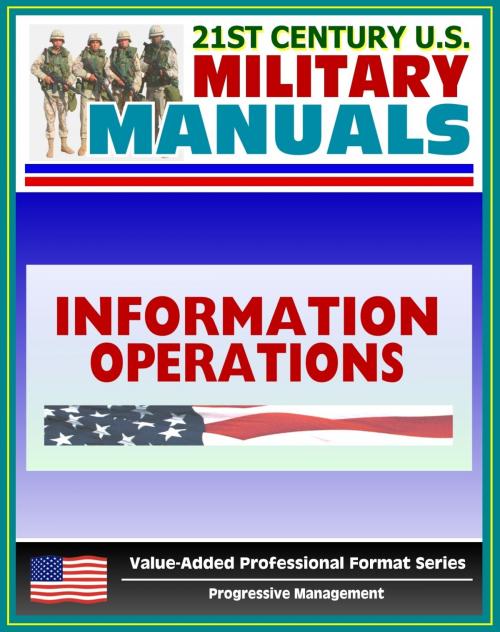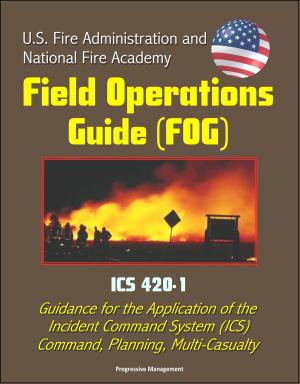21st Century U.S. Military Manuals: Information Operations Field Manual - FM 100-6
Nonfiction, History, Military| Author: | Progressive Management | ISBN: | 9781466158108 |
| Publisher: | Progressive Management | Publication: | September 13, 2011 |
| Imprint: | Smashwords Edition | Language: | English |
| Author: | Progressive Management |
| ISBN: | 9781466158108 |
| Publisher: | Progressive Management |
| Publication: | September 13, 2011 |
| Imprint: | Smashwords Edition |
| Language: | English |
Part of our value-added professional format series, the Information Operations Field Manual (FM 100-6) addresses the operational context of information operations (IO), relevant terminology, and the environment of information operations. It supports battle command and provides guidelines for commanders that conduct IO to support all phases of the force-projection operating environment, including planning and executing early entry and force-projection operations in joint and multinational settings.
Military operations occur in peace and war. The traditional focus when discussing information and C2 was electronic warfare (EW), electronic countermeasure (ECM), and electronic counter countermeasure (ECCM) operations that take place during war. The focus of this manual is on command and control warfare (C2W), public affairs (PA), and civil affairs (CA). All are operations that the Army currently uses to gain and maintain information dominance as well as effective C2. Successful operations require effective C2 to transform military capabilities into applied military power. The more effective the force's C2 system, the more completely its capabilities can be realized in peace or war.
As the Army's capstone doctrine for IO, this manual supports soldiers and leaders that execute IO to support military operations. Not only does the doctrine herein provide commanders and their staffs with guidance to conduct information operations, it also serves as the foundation for development of US Army tactics, techniques, and procedures (TTP) manuals. It is also the foundation to refine existing training support packages (TSPs), mission training plans (MTPs), training center and unit exercises, and service school curricula. The manual provides a basis to examine organizations and materiel developments applicable to IO.
This doctrine applies to the total Army—active and reserve components and Army civilians. It is specifically oriented at the operational and tactical levels of military operations. It may be useful to other services, nonmilitary agencies, and allies involved in such operations. The proponent of this manual is HQ TRADOC.
This FM has been converted for accurate flowing-text e-book format reproduction.
As a bonus, this reproduction includes FM-1, The Army Field Manual, a capstone manual containing the vision for the Army - sold separately for $5.99. FM 1 establishes the fundamental principles for employing Landpower. The most important of these are the Army's operational concept and the fundamentals that support it. They form the foundation for all Army doctrine. All Soldiers should understand and internalize them. FM 1 describes the American profession of arms, the Army's place in it, and what it means to be a professional Soldier.
This is a privately authored news service and educational publication of Progressive Management.
Part of our value-added professional format series, the Information Operations Field Manual (FM 100-6) addresses the operational context of information operations (IO), relevant terminology, and the environment of information operations. It supports battle command and provides guidelines for commanders that conduct IO to support all phases of the force-projection operating environment, including planning and executing early entry and force-projection operations in joint and multinational settings.
Military operations occur in peace and war. The traditional focus when discussing information and C2 was electronic warfare (EW), electronic countermeasure (ECM), and electronic counter countermeasure (ECCM) operations that take place during war. The focus of this manual is on command and control warfare (C2W), public affairs (PA), and civil affairs (CA). All are operations that the Army currently uses to gain and maintain information dominance as well as effective C2. Successful operations require effective C2 to transform military capabilities into applied military power. The more effective the force's C2 system, the more completely its capabilities can be realized in peace or war.
As the Army's capstone doctrine for IO, this manual supports soldiers and leaders that execute IO to support military operations. Not only does the doctrine herein provide commanders and their staffs with guidance to conduct information operations, it also serves as the foundation for development of US Army tactics, techniques, and procedures (TTP) manuals. It is also the foundation to refine existing training support packages (TSPs), mission training plans (MTPs), training center and unit exercises, and service school curricula. The manual provides a basis to examine organizations and materiel developments applicable to IO.
This doctrine applies to the total Army—active and reserve components and Army civilians. It is specifically oriented at the operational and tactical levels of military operations. It may be useful to other services, nonmilitary agencies, and allies involved in such operations. The proponent of this manual is HQ TRADOC.
This FM has been converted for accurate flowing-text e-book format reproduction.
As a bonus, this reproduction includes FM-1, The Army Field Manual, a capstone manual containing the vision for the Army - sold separately for $5.99. FM 1 establishes the fundamental principles for employing Landpower. The most important of these are the Army's operational concept and the fundamentals that support it. They form the foundation for all Army doctrine. All Soldiers should understand and internalize them. FM 1 describes the American profession of arms, the Army's place in it, and what it means to be a professional Soldier.
This is a privately authored news service and educational publication of Progressive Management.















